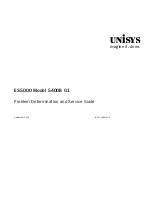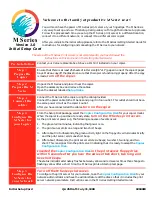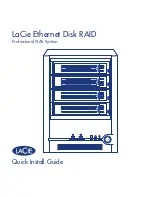
Extended Front Panel System Board
Intel
®
Carrier Grade Server TIGPT1U TPS
Revision
1.0
34
4.4.6
System Fault Relays
The front panel board contains four relays. These relays are for power, critical, major and minor
alarms. The relays are controlled via the SMBus. See Section 4.4.7 for programming
information.
4.4.7
Server Management Bus (SMBus) Interface
The Torrey Pines baseboard communicates to the XFPB via the auxiliary I
2
C bus to support
server management functions. The I
2
C interface operates at less than 20 Khz rate to support
SMBus functionality. Two I/O expanders on the XFPB are used as slave devices to interface to
the SMBus.
The first device (U3H1) is used to support the control and monitoring of the front panel alarms.
All signals at U3H1 that interface to the alarms circuitry are active low. During power up, the
device will reset all I/Os to the default High state. However, during system soft resets, the
device requires a software command to reinitialize all I/Os to the default inactive state.
Access to U3H1 during a write cycle can be performed by writing to address 0 x 40. Access to
U3H1 during a read cycle can be performed by writing to address 0 x 41. Refer to Table 4-6 for
an I/O map of U3H1.
The second device (U2H1) is used to support the control and monitoring of the two SCSI hard
drives. Also, during a drive fault condition, U2H1 receives commands from the baseboard to
activate the proper drive fault LED to provide visual indications of a fault condition. All signals at
U2H1 that interface to the SCSI control circuitry are active low. During power up, the device will
reset all I/Os to the default High state. However, during system soft resets, the device requires
a software command to reinitialize all I/Os to the default inactive state.
Access to U2H1 during a write cycle can be performed by writing to address 0 x 44. Access to
U2H1 during a read cycle can be performed by writing to address 0 x 45. Refer to Table 4-7 for
an I/O map of U2H1.
Table 4-6. Alarms SMBus I/O Mapping
Bit I/O
Name
Description
0
O
Power alarm
Writing 0 turns on the power alarm relay and illuminates the POWER LED,
writing 1 turns both off. The relay and LED may also be turned on by a
FAN_FAIL_L signal.
1
O
Critical alarm
Writing 0 turns on the critical alarm relay and illuminates the CRITICAL LED,
writing 1 turns both off.
2
O
Major alarm
Writing a 1 to 0 edge will turn on the flip-flip that enables major alarm relay.
Writing a 1 will turn off the major alarm relay or a MAJOR_RESET signal input.
MAJOR LED in on when output is 0, off when output is 1.
1
3
O
Minor alarm
Writing a 1 to 0 edge will turn on the flip-flip that enables major alarm relay.
Writing a 1 will turn off the major alarm relay or a MINOR_RESET signal input.
MINOR LED in on when output is 0, off when output is 1.
1
4 I Major
alarm
sense
Senses the state of the major alarm relay. 0 relay is on, 1 relay is off. This
allows software to detect if the MAJOR_RESET signal was activated. Always
write 1 during write operations.
5 I Minor
alarm
sense
Senses the state of the minor alarm relay. 0 relay is on, 1 relay is off. This
allows software to detect if the MINOR_RESET signal was activated. Always
write 1 during write operations.
















































